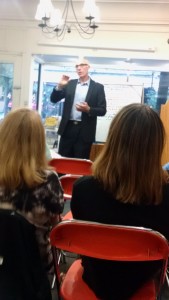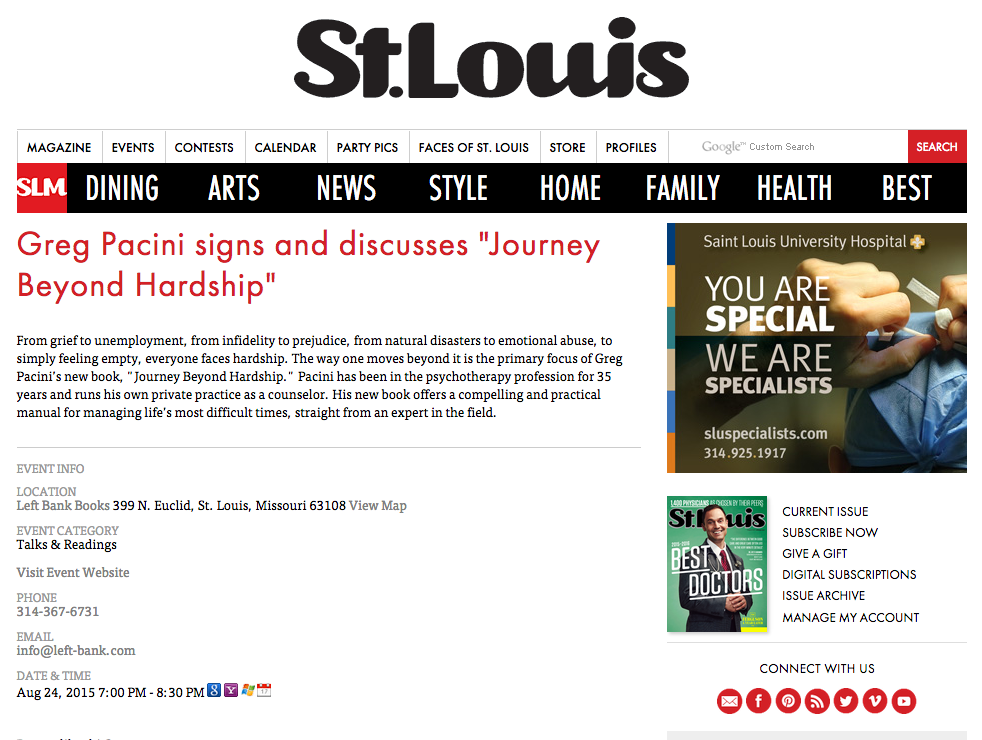
Tag Archives: Grief
The tragedies of Paris, Beirut and Russia threw those countries into deep sorrow, and at the same time, opened wounds of grief in hearts around the world. When someone we love is hurting from grief, we want desperately to take that pain away. Consequently we say things we hope will help. But words often miss the mark. When someone is grieving, just being there is more important than anything we can say.
“It’ll get better,” “God has a plan,” “I understand”: these words are meant to make the person we love feel better. Having worked with the chronically and terminally ill for more than 25 years, I can tell you, more often than not and despite our best intentions, words like those don’t help.
In fact, words like, “Be strong,” or, “It could be worse,” or, “It’ll all make sense one day,” often shut down someone expressing strong emotion. And when we’re in a world of hurt, literally and figuratively, most of us just want someone to share our pain, not shut it down.
Instead of words, let your presence speak for you.
No words can take away the deepest pain of loss. Mostly words just get in the way. But when we simply show up for someone that’s grieving, our presence says more than any words could. Our presence lightens the weight of isolation someone grieving might feel. Being there also says, “I can handle your pain, no matter what.” This makes a difference.
Our world, our selves, seem so often full with pain. Or is it suffering we feel? What’s the difference? The difference is choice. In this blog we’ll explore that difference and how choosing might help.
This human thing we do has held me for sixty-one years. Of those years, thirty-five have been spent as a psychotherapist supporting folks in all sorts of pain and suffering. In this blended process of life and profession, a distinction between pain and suffering has developed.
It seems pain comes with life. There’s the literal pain we feel when we are hurt physically. I remember that pain when I was four or five. My little legs took off and jumped into a pile of dirt in a field across the street. We lived in Florida at the time. There was a stake hidden in the pile that gashed me.
Then there’s the affective pain we feel when we are hurt mentally or emotionally. I remember that hurt when I saw my dad cry for the first time after his mother died. We were driving in our station wagon from the funeral. My pain was seeing this powerful figure in a light that scared me.
There are countless ways we may feel pain physically: broken bone, headache, hunger, disease, sore muscle, gunshot, arthritis…on and on.
There are countless ways we may feel mental or emotional pain: heartbreak, news of job loss, victimization through abuse or prejudice, addiction, and so many more.
So how is this pain different from suffering?
All the physical, emotional and mental pains just listed (sad as it might be) are part of the world we live in. And when one of them occurs, it’s natural to feel pain. Injured in a car accident, you’re going to feel physical and emotional pain. It’s what we humans do. The pain is an automatic response designed to teach us. It’s the idea that you don’t put your hand on a hot stove more than once. This process of growth through pain is beyond our control. Without physical pain, we would not survive as a species.
Similarly, we need the pain of all our difficult emotions and the pleasure of all our positive emotions to tell us what direction helps us and what direction hurts us.
In this sense, physical, emotional, mental and perhaps even spiritual pain intends to guide us, all be it uncomfortable learning. And when our systems are working well, the initial pain is all we need to be pointed in a better direction.
This is where the distinction between pain and suffering begins to emerge.
A number of years back, I led a weekly support group for young physicians. At one meeting a doc came in late, clearly upset, and soon shared deep concerns about “a mistake” made with a patient earlier in the day. That doctor was in emotional and mental pain. We were all present and listening. The doctor’s reactions were real and reasonable.
But the doctor’s concern expanded into self-chastisement that wouldn’t let up. Eventually I simply asked, “When did you figure out what you would have done differently?”
“Almost immediately,” the physician responded.
Indirectly, I was teaching about the difference between pain and suffering. That doctor felt pain as soon as the negative impact on the patient was realized. And right after, that same pain helped that doctor figure a better way. This is the pain that comes with life, and guides us. But that physician’s rumination about the “mistake” was becoming suffering.
Pain is a now experience. Suffering is thinking about pain.
If you’re alive, you experience pain. Suffering, or thinking about pain, is optional.
Pain is the true teacher. Suffering is pain in sheep’s clothing.
As strange as it may sound, pain has something to give us. Suffering only takes: it takes our attention, it takes our time, it takes our joy. There’s no cheese down that path.
We will all make mistakes. And if those mistakes have negative consequences for us or others, most will feel some degree of discomfort and maybe even pain. But if we find ourselves hours, days or weeks later thinking through something we did or didn’t do or should have done, we are now suffering.
Suffering in this way can also take the form of thinking and rethinking something someone said or did to us. Yes, the initial injury hurt and caused pain. But if we are still thinking about it days later, we are creating suffering for ourselves. Suffering is a close cousin to worry and anxiety, all of which are fear’s offspring.
Two monks were given the privilege of walking from their monastery to the neighboring village for supplies. Before leaving they were strictly instructed not to speak with anyone, especially women. More importantly they were told not to touch women.
While getting supplies in the village, it began to rain…a lot. The dirt roads were now running with mud. Heading out of town and still in their silence, the monks came upon a well-dressed woman stranded on a corner. One monk handed his supplies to the other, picked up the woman and carried her across the road to drier ground.
Miles later, the stunned monk broke the silence: “We aren’t to speak with women, much less touch them, but you carried her across the road!”
“And I put her down miles ago. You are still carrying her,” said the other.
When we can’t put the initial pain down, we are suffering. Nothing wrong with it. It just steals our energy and keeps us unavailable to the life before us.
It seems that most pain has a shelf life. Eventually the event or circumstance that created our pain passes, and a more comfortable way is available once again. And while pain has a shelf life, suffering doesn’t. Suffering will be with us as long as we create it.
That’s right. Life creates pain. We create suffering. And we create suffering by our choices.
First of all, it’s important to say, there is no shame in suffering. If you are suffering, the last thing you need is for someone to tell you, “You did this to yourself.” Your suffering may hardly be bearable. And now you’re hearing you may be creating your suffering.
But if we create our suffering, that means we can uncreate it. If suffering is a product of my choice, perhaps I can choose something else.
Psychiatrist and concentration camp survivor, Viktor Frankl, MD, PhD, wrote about fellow survivors in his classic, Man’s Search For Meaning, who found a way to not suffer in the face of daily pain. Even though many of them had family members tortured or killed one after the other, these same people scrawled images of butterflies and flowers on the wooden walls of their horrific barracks.
It is your birthright to feel whatever you feel. But when you tire of suffering, here’s a simple, guiding principle to help you move forward. When you find yourself emotionally, mentally, or spiritually uncomfortable, but the moment itself offers no threat to your comfort, you may be doing one of three things which can produce suffering:
1) Thinking about something painful from your past
2) Imagining something painful in your future
3) Comparing yourself to someone else
The solution: consider the choice to lovingly bring yourself out of your mind, into your body, and into the moment that is full of life, waiting for you once you release the suffering.
Counseling the chronically and terminally ill for 15 years taught me lessons of the mind, the heart, the body and the soul. So in 2005, Journey Beyond Diagnosis was published with the hope of capturing the wisdom of those facing life-threatening disease.
By 2010, that book was virtually sold out. But people were still being diagnosed. And the familiar, internal nudge to write woke back up: the nudge to bring forward all the new knowledge from these brave, honest, scared, strong, desperate, daring and powerful people. Consequently, a second edition of Journey Beyond Diagnosis started taking shape.
Then life intervened. Tragedy struck in my own life, and it was hard. Writing became labored, and eventually ground to a stop. Making my way through tough times took what energy I had. Writing about tragedy while enduring it was not doable for me.
Once in a while, my hands could make words on the laptop. And then they couldn’t. This pecking at the second edition continued. With time, life started to feel a little better. People I trusted read bits and pieces of this edition, and in different ways encouraged me to not only keep writing, but to broaden the reach of the new material.
By now it had been 25 years counseling the chronically and terminally ill and 35 years as a psychotherapist for people suffering all matter of injury: infidelity, financial downfall, physical and sexual abuse, prejudice, death of a loved one, addiction, anxiety, depression, miscarriage, and just feeling empty for some clear reason, or no reason at all.
Given my recent reference for tragedy, earlier feedback that Journey Beyond Diagnosis was helpful even to those who had not experienced a diagnosis, and the mounting support to create a book that might benefit anyone dealing with life’s difficulties, the focus of the second edition shifted and became Journey Beyond Hardship.
Writing became more fluid and productive. An early draft of Journey Beyond Hardship was completed in the fall of 2014.
One of the first to see the new material was New York Times bestseller, Anita Moorjani. I took a chance and sent a galley proof of the book, inviting Anita to write the foreword. Tears streamed down my face weeks later at the news that she had accepted my invitation. My heart leapt again, when, through utter serendipity, New York Times bestseller, Larry Dossey, MD, sent me an endorsement. Any author would feel tremendously fortunate to have either of these magnificent human beings affiliated with one’s work. But to have both involved was overwhelming.
With Anita Moorjani’s and Dr. Dossey’s contributions now set for the book’s cover, Journey Beyond Hardship was made public in April of 2015.
Many say that writing and sharing yourself publically is daunting. There have been moments. Mostly, it’s been about honoring the stirring to bring to others what has been and continues to be given to me. Daily, my work steeps me in some of the richest elements of the human experience. There would be no rest if that potent knowledge did not get passed on.
So it’s with profound satisfaction and hope that Journey Beyond Hardship is now shared, along with these related comments from recent book signings:
“The presentation was so informative and clearly presented, I look forward to reading Greg’s book.” Christine Bubbeo
“Inspiring! Unique experience to hear the words of my heart interpreted and translated for me to understand in a new way.” Emily Thomas
“Excellent. I can’t wait to read it.” Julie Harig
“Illuminating book – a bright light for the dark road of hardship. Love the practical suggestions.” Rhonda Leifheit
“Hope is like a path on the hillside. Once there was no path, but as villagers traveled that place, a way appeared.” Those beautiful words by Lin Yutang were written well before our current understanding of neuropaths and neuroreceptors. And yet they perfectly describe what happens in the brain and on the surface of the cells, as we open ourselves more and more to hope, or any emotion. Here’s how it works.
In the hit movie, Trainwreck, Amy Schumer’s character, also named Amy, shows us in the first half of the show how our childhood wounds can express themselves in our adult lives. Given the monogamy-is-unrealistic motto firmly planted in Amy’s young mind by her dad, she lives out that approach in adulthood, hooking up with lots of men and drinking to quiet any pain.
Death of a loved one is hardship. In the hit movie, Trainwreck, Amy Schumer’s character, also named Amy, struggles to connect deeply with others, grieves her father’s death, and begins a healing journey. Let’s take a look at all three aspects of the film, and life.
Endorsed by two New York Times bestselling authors.”


